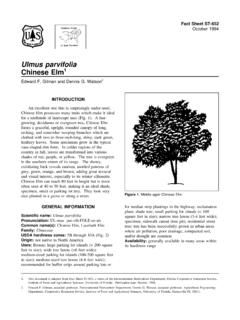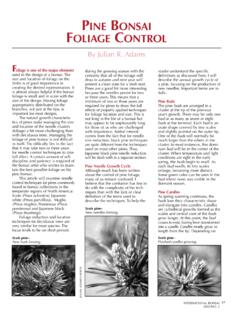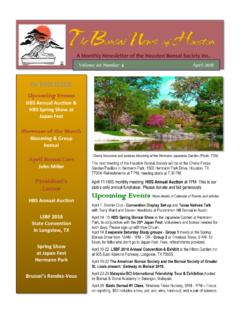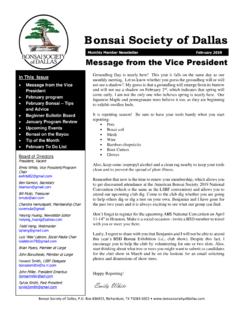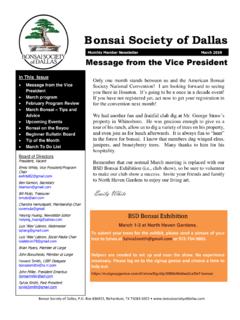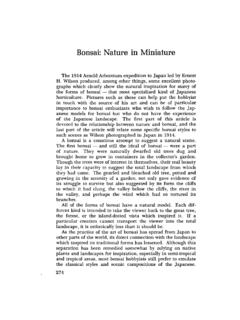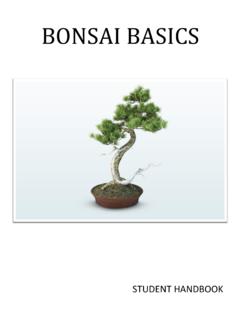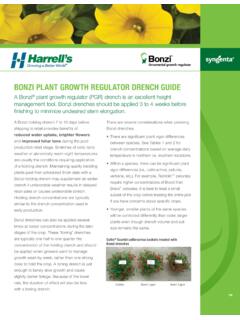Transcription of Zelkova serrata - University of Florida
1 Fact Sheet ST-677 October 1994 Zelkova serrataFigure Japanese Zelkova1 Edward F. Gilman and Dennis G. Watson2 INTRODUCTIONZ elkova is often listed as a replacement forAmerican Elm since it has roughly the same vaseshape and grows 90 to 100 feet tall with a 60 to 80-foot spread (Fig. 1). But no tree will truly match thegrace and elegance of the American Elm. Zelkova ismassive, with the trunk capable of growing to four feetor more in diameter. It has a moderate growth rateand likes a sunny exposure. Branches are morenumerous and smaller in diameter than American are to 4 inches long, turning a brilliantyellow, orange, or burnt umber in the INFORMATIONS cientific name: Zelkova serrataPronunciation:zell-KOE-vuh sair-AY-tuhCommon name(s):Japanese Zelkova , Saw-LeafZelkovaFamily:UlmaceaeUSDA hardiness zones:5 through 8 (Fig. 2)Origin:not native to North AmericaUses:Bonsai; large parking lot islands (> 200 squarefeet in size); wide tree lawns (>6 feet wide);medium-sized parking lot islands (100-200 square feetin size); medium-sized tree lawns (4-6 feet wide);recommended for buffer strips around parking lots orfor median strip plantings in the highway; shade tree;sidewalk cutout (tree pit); residential street tree.
2 Treehas been successfully grown in urban areas where airpollution, poor drainage, compacted soil, and/ordrought are commonAvailability:generally available in many areas withinits hardiness rangeDESCRIPTIONH eight:55 to 80 feetSpread:50 to 75 feetCrown uniformity:symmetrical canopy with aregular (or smooth) outline, and individuals have moreor less identical crown formsCrown shape:vase shapeCrown density:moderateGrowth rate: document is adapted from Fact Sheet ST-677, a series of the Environmental Horticulture Department, Florida Cooperative Extension Service,Institute of Food and Agricultural Sciences, University of Florida . Publication date: October F. Gilman, associate professor, Environmental Horticulture Department; Dennis G. Watson, associate professor, Agricultural EngineeringDepartment, Cooperative Extension Service, Institute of Food and Agricultural Sciences, University of Florida , Gainesville FL serrata -- Japanese ZelkovaPage 2 FoliageFigure area represents potential planting arrangement:alternate (Fig.)
3 3)Leaf type:simpleLeaf margin:serrateLeaf shape:oblong; ovateLeaf venation:pinnateLeaf type and persistence:deciduousLeaf blade length:less than 2 inchesLeaf color:greenFall color:copper; orange; red; yellowFall characteristic:showyFlowerFlower characteristics:inconspicuous and notshowy; spring floweringFruitFruit shape:ovalFruit length:< .5 inchFruit covering:dry or hardFruit characteristics:does not attract wildlife;inconspicuous and not showy; no significant litterproblemTrunk and BranchesTrunk/bark/branches:grow mostly upright and willnot droop; showy trunk; should be grown with a singleleader; no thornsPruning requirement:requires pruning to developstrong structureBreakage:susceptible to breakage either at the crotchdue to poor collar formation, or the wood itself isweak and tends to breakCurrent year twig color:brownCurrent year twig thickness:thinCultureLight requirement:tree grows in full sunSoil tolerances:clay; loam; sand; slightly alkaline;acidic; occasionally wet.
4 Well-drainedDrought tolerance:highAerosol salt tolerance:moderateZelkova serrata -- Japanese ZelkovaPage 3 OtherFigure of Japanese :surface roots are usually not a problemWinter interest:no special winter interestOutstanding tree:not particularly outstandingInvasive potential:little, if any, potential at this timeOzone sensitivity:sensitive or moderately tolerantVerticillium wilt susceptibility:not known to besusceptiblePest resistance:long-term health usually notaffected by pestsUSE AND MANAGEMENTU nfortunately, the branches on Zelkova are oftenclumped together on the trunk at one point. Doubleand multiple trunks or leaders with embedded bark arealso common. This is not a desirable form forplanting in urban areas and needs to be prevented, orcorrected, on existing trees. Purchase trees withbranches spaced along the trunk so they can develop asecure hold onto the trunk. These will be hard to findbut insist on it! Be sure that branches remain less thanabout half the diameter of the trunk to maintain astrong, durable form.
5 Encourage nurserymen to growtrees with good trunk and branch tree will tolerate most soil types, includingthose with a pH to about , but prefers a moist deeploam. It is reportedly risky to transplant in the trees are fairly drought-tolerant, requiringlittle irrigation unless located in sandy soil. It makes awonderful street tree even in restricted-soil tree pits,and is almost pest free. The crowns will eventuallygrow together if trees are planted on 30-foot-centers,forming a wonderful shaded street. This is a tough,urban tree which is often planted along streets indowntown and residential include: Green Vase somewhatresembles the vase shape of American Elms, is moreupright in habit and tolerant of pollution, makes agreat city street tree and produces a taller and narrowertree than Village Green; Village Green alsoresembles the shape of the American Elm and is morewinter hardy than Green Vase , and may have astraighter disease-free as it resists Dutch Elmdisease and Elm leaf is subject to canker diseases particularly ifthe trunk is repeatedly wounded.
6 Avoid wounding andmaintain tree health.

